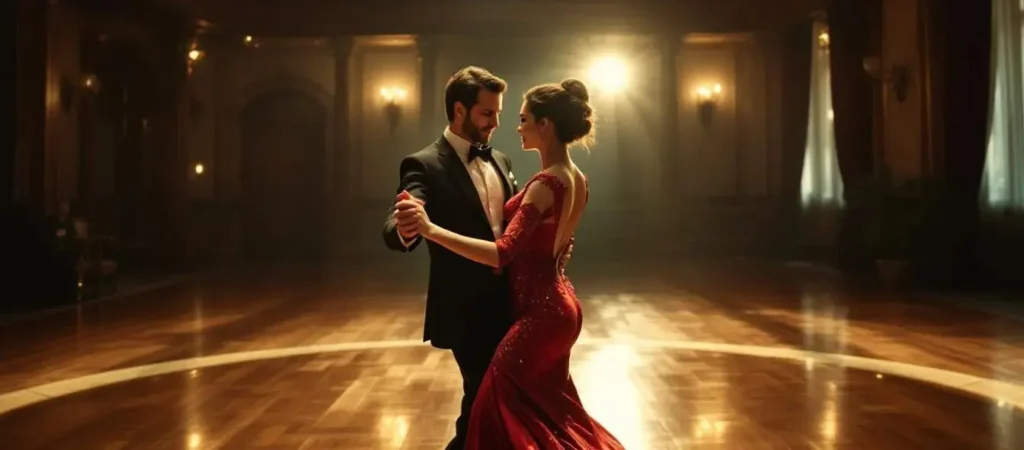The mesmerizing quality of American Smooth dancing comes from its continuous, gliding movement across the floor. While the long, flowing lines are the foundation, it’s the turns that add breathtaking dynamism and elegance. Unlike the fixed, closed position of International Standard, American Smooth gives partners the freedom to break away and turn independently, creating theatrical, sweeping shapes.
But a beautiful turn is more than just spinning around. It’s a masterful blend of technique, balance, and connection. For both beginners and seasoned dancers, understanding and perfecting the mechanics of a turn can elevate your dancing from competent to captivating.
The anatomy of a smooth turn
A successful turn in smooth dancing is a full-body action, built from the ground up.
- Core strength: Your core is the epicenter of your turns. Engaging your abdominal, oblique, and lower back muscles provides the stability and control needed to execute precise and balanced rotations.
- Posture and frame: Maintaining a strong, upright frame is essential. Your spine should be long and aligned over your standing foot, preventing you from wobbling or losing control mid-turn. In American Smooth, the frame can open and close, but it must remain connected and responsive to your partner’s lead.
- Shoulder and hip separation: Advanced smooth turns often use a spiral-like action, where the upper and lower body rotate at different speeds. For example, a leader might initiate a turn with their shoulders while the follower uses a foot twist to create a harmonious rotation.
- Footwork: Precise footwork is critical. Depending on the turn, you may pivot on the ball of your foot, twist on a flat foot, or step and turn in a chasse-like sequence. The goal is to keep your feet connected to the floor and your weight centered.
- Spotting: This technique is a game-changer for maintaining balance and preventing dizziness, especially during rapid turns. By keeping your eyes fixed on a single spot, you can control the speed and finish of your rotation.
Common turns in smooth dances
Each smooth dance has its signature turns, but a few core types form the building blocks of most choreography.
- Natural and reverse turns (Waltz, Foxtrot): These are the foundational turning actions in ballroom. A natural turn is a continuous clockwise (right) rotation, while a reverse turn is counter-clockwise (left). In smooth, these can be danced in both open and closed positions.
- Spin turns (Waltz, Foxtrot): A high-level, multi-rotation figure that features a couple pivoting rapidly around a central point, often in a continuous, fast-paced sequence.
- Pivot turns (Foxtrot, Tango): A traveling turn, often a half-rotation, where the body turns over the standing foot while the free leg stays behind. Pivot turns can be strung together to quickly change direction.
- Spiral turns (Waltz, Foxtrot): A graceful, swirling turn, often performed by the follower, that involves a rotation on one foot with the other foot wrapped around the leg. It creates a beautiful, flowing line and a momentary pause in the music.
- Underarm turns (Foxtrot, Tango): These are open turns, most often for the follower, that are led by a raised hand. In smooth, they can be a stylish way to transition between open and closed positions.
How to practice your turns
Improving your turns requires patience and a focus on detail.
- Start slow: Don’t rush into fast rotations. Practice each turn slowly, focusing on your balance, posture, and weight placement.
- Go solo: A great way to build your balance and technique is to practice your turns alone. This allows you to focus on your own movements without the added challenge of a partner.
- Strengthen your body: Incorporate exercises that target your core, ankles, and legs, such as planks, calf raises, and single-leg balances.
- Break down the steps: Work on the components of a turn individually. Practice your spotting by itself, or drill the specific foot actions for a pivot turn.
- Don’t forget to breathe: Tension is the enemy of smooth, fluid movement. Relax your body and maintain a steady breath to avoid stiffness and execute turns with greater ease.
Turns are an exciting part of the smooth dance journey. By focusing on fundamental technique and consistent practice, you can transform your rotations into breathtaking expressions of artistry on the dance floor.


